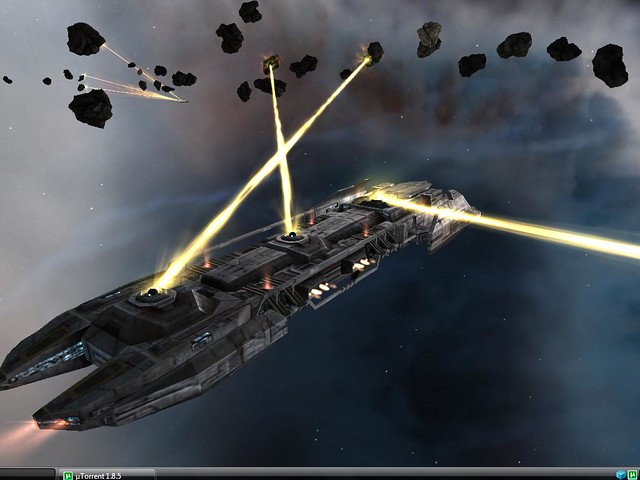Well, this would certainly be interesting.
Asteroid Mining Venture Backed by Google Execs, James Cameron Unveiled
by Mike Wall, SPACE.com Senior WriterDate: 23 April 2012 Time: 09:00 PM ET
A newly unveiled company with some high-profile backers — including filmmaker James Cameron and Google co-founder Larry Page — is set to announce plans to mine near-Earth asteroids for resources such as precious metals and water.
Planetary Resources, Inc. intends to sell these materials, generating a healthy profit for itself. But it also aims to advance humanity's exploration and exploitation of space, with resource extraction serving as an anchor industry that helps our species spread throughout the solar system.

Small, water-rich near-Earth asteroids can be captured by spacecraft, allowing their resources to be extracted, officials with the new company Planetary Resources say.
CREDIT: Planetary Resources, Inc
"If you look at space resources, the logical next step is to go to the near-Earth asteroids," Planetary Resources co-founder and co-chairman Eric Anderson told SPACE.com. "They're just so valuable, and so easy to reach energetically. Near-Earth asteroids really are the low-hanging fruit of the solar system."
Planetary Resources is officially unveiling its asteroid-mining plans at 1:30 p.m. EDT (1730 GMT) Tuesday (April 24) during a news conference at Seattle's Museum of Flight.
Two of the resources the company plans to mine are platinum-group metals and water, Anderson said.
Platinum-group metals — ruthenium, rhodium, palladium, osmium, iridium, and platinum — are found in low concentrations on Earth and can be tough to access, which is why they're so expensive. In fact, Anderson said, they don't occur naturally in Earth's crust, having been deposited on our planet over the eons by asteroid impacts.
"We're going to go to the source," Anderson said. "The platinum-group metals are many orders of magnitude easier to access in the high-concentration platinum asteroids than they are in the Earth's crust."
And there are a lot of precious metals up there waiting to be mined. A single platinum-rich space rock 1,650 feet (500 meters) wide contains the equivalent of all the platinum-group metals ever mined throughout human history, company officials said.
"When the availability of these metals increase[s], the cost will reduce on everything including defibrillators, hand-held devices, TV and computer monitors, catalysts," Planetary Resources co-founder and co-chairman Peter Diamandis said in a statement. "And with the abundance of these metals, we’ll be able to use them in mass production, like in automotive fuel cells."
Many asteroids are rich in water, too, another characteristic the company plans to exploit. Once extracted, this water would be sold in space, providing significant savings over water launched from the ground.
Asteroid water could help astronauts stay hydrated and grow food, provide radiation shielding for spaceships and be broken into its constituent hydrogen and oxygen, the chief components of rocket fuel, Anderson said.
Planetary Resources hopes its mining efforts lead to the establishment of in-space "gas stations" that could help many spacecraft refuel, from Earth-orbiting satellites to Mars-bound vessels.
"We're really talking about enabling the exploration of deep space," Anderson said. "That's what really gets me excited." [Future Visions of Human Spaceflight]
In addition to Page, Planetary Resources counts among its investors Ross Perot Jr., chairman of The Perot Group and son of the former presidential candidate; Eric Schmidt, executive chairman of Google; K. Ram Shriram, Google board of directors founding member; and Charles Simonyi, chairman of Intentional Software Corp., who has taken two tourist flights to the International Space Station.
Cameron serves the company as an adviser, as does former NASA space shuttle astronaut Tom Jones.

Planetary Resources, Inc. plans to send robotic probes out to prospect near-Earth asteroids, gauging their potential stores of water and platinum-group metals.
CREDIT: Planetary Resources, Inc.
The plan
The company is not ready to break ground on an asteroid just yet. Before that can happen, it needs to do some in-depth prospecting work.
Of the roughly 8,900 known near-Earth asteroids, perhaps 100 or 150 are water-rich and easier to reach than the surface of the moon, Anderson said. Planetary Resources wants to identify and characterize these top targets before it does anything else.
To that end, it has designed a high-performance, low-cost space telescope that Anderson said should launch to low-Earth orbit within the next 18 to 24 months. This telescope will make observations of its own but also serve as a model for future instruments that will journey near promising asteroids and peer at them in great detail.
The prospecting phase should take a couple of years or so, Anderson added.
"We will then, at that time, determine which of these objects to pursue first for resource extraction, and what mission we'll be facilitating," he said. "Before you decide where to put the gas station, you've got to understand where the trucks are going to be driving by."
Mining activities will be enabled by swarms of unmanned spacecraft, according to company materials. Planetary Resources will focus on near-Earth asteroids, with no immediate plans to extend its reach to the asteroid belt between Mars and Jupiter or to the surface of the moon, Anderson said.
He declined to estimate when Planetary Resources would begin extracting metals or water from space rocks, saying there are too many variables to lay out a firm timeline. But a recent study sponsored by Caltech's Keck Institute for Space Studies estimated that a 500-ton near-Earth asteroid could be snagged and dragged to the moon's orbit by 2025, at a cost of about $2.6 billion.
Whatever Planetary Resources' exact schedule may be, Anderson said the company is already well on its way to making things happen.
"We're out there right now, talking to customers," Anderson said. "We are open for discussions with companies — aerospace companies, mining companies, prospecting companies, resource companies. We're out working in that field, to really open up the solar system for business."
by Mike Wall, SPACE.com Senior WriterDate: 23 April 2012 Time: 09:00 PM ET
A newly unveiled company with some high-profile backers — including filmmaker James Cameron and Google co-founder Larry Page — is set to announce plans to mine near-Earth asteroids for resources such as precious metals and water.
Planetary Resources, Inc. intends to sell these materials, generating a healthy profit for itself. But it also aims to advance humanity's exploration and exploitation of space, with resource extraction serving as an anchor industry that helps our species spread throughout the solar system.

Small, water-rich near-Earth asteroids can be captured by spacecraft, allowing their resources to be extracted, officials with the new company Planetary Resources say.
CREDIT: Planetary Resources, Inc
"If you look at space resources, the logical next step is to go to the near-Earth asteroids," Planetary Resources co-founder and co-chairman Eric Anderson told SPACE.com. "They're just so valuable, and so easy to reach energetically. Near-Earth asteroids really are the low-hanging fruit of the solar system."
Planetary Resources is officially unveiling its asteroid-mining plans at 1:30 p.m. EDT (1730 GMT) Tuesday (April 24) during a news conference at Seattle's Museum of Flight.
Two of the resources the company plans to mine are platinum-group metals and water, Anderson said.
Platinum-group metals — ruthenium, rhodium, palladium, osmium, iridium, and platinum — are found in low concentrations on Earth and can be tough to access, which is why they're so expensive. In fact, Anderson said, they don't occur naturally in Earth's crust, having been deposited on our planet over the eons by asteroid impacts.
"We're going to go to the source," Anderson said. "The platinum-group metals are many orders of magnitude easier to access in the high-concentration platinum asteroids than they are in the Earth's crust."
And there are a lot of precious metals up there waiting to be mined. A single platinum-rich space rock 1,650 feet (500 meters) wide contains the equivalent of all the platinum-group metals ever mined throughout human history, company officials said.
"When the availability of these metals increase[s], the cost will reduce on everything including defibrillators, hand-held devices, TV and computer monitors, catalysts," Planetary Resources co-founder and co-chairman Peter Diamandis said in a statement. "And with the abundance of these metals, we’ll be able to use them in mass production, like in automotive fuel cells."
Many asteroids are rich in water, too, another characteristic the company plans to exploit. Once extracted, this water would be sold in space, providing significant savings over water launched from the ground.
Asteroid water could help astronauts stay hydrated and grow food, provide radiation shielding for spaceships and be broken into its constituent hydrogen and oxygen, the chief components of rocket fuel, Anderson said.
Planetary Resources hopes its mining efforts lead to the establishment of in-space "gas stations" that could help many spacecraft refuel, from Earth-orbiting satellites to Mars-bound vessels.
"We're really talking about enabling the exploration of deep space," Anderson said. "That's what really gets me excited." [Future Visions of Human Spaceflight]
In addition to Page, Planetary Resources counts among its investors Ross Perot Jr., chairman of The Perot Group and son of the former presidential candidate; Eric Schmidt, executive chairman of Google; K. Ram Shriram, Google board of directors founding member; and Charles Simonyi, chairman of Intentional Software Corp., who has taken two tourist flights to the International Space Station.
Cameron serves the company as an adviser, as does former NASA space shuttle astronaut Tom Jones.

Planetary Resources, Inc. plans to send robotic probes out to prospect near-Earth asteroids, gauging their potential stores of water and platinum-group metals.
CREDIT: Planetary Resources, Inc.
The plan
The company is not ready to break ground on an asteroid just yet. Before that can happen, it needs to do some in-depth prospecting work.
Of the roughly 8,900 known near-Earth asteroids, perhaps 100 or 150 are water-rich and easier to reach than the surface of the moon, Anderson said. Planetary Resources wants to identify and characterize these top targets before it does anything else.
To that end, it has designed a high-performance, low-cost space telescope that Anderson said should launch to low-Earth orbit within the next 18 to 24 months. This telescope will make observations of its own but also serve as a model for future instruments that will journey near promising asteroids and peer at them in great detail.
The prospecting phase should take a couple of years or so, Anderson added.
"We will then, at that time, determine which of these objects to pursue first for resource extraction, and what mission we'll be facilitating," he said. "Before you decide where to put the gas station, you've got to understand where the trucks are going to be driving by."
Mining activities will be enabled by swarms of unmanned spacecraft, according to company materials. Planetary Resources will focus on near-Earth asteroids, with no immediate plans to extend its reach to the asteroid belt between Mars and Jupiter or to the surface of the moon, Anderson said.
He declined to estimate when Planetary Resources would begin extracting metals or water from space rocks, saying there are too many variables to lay out a firm timeline. But a recent study sponsored by Caltech's Keck Institute for Space Studies estimated that a 500-ton near-Earth asteroid could be snagged and dragged to the moon's orbit by 2025, at a cost of about $2.6 billion.
Whatever Planetary Resources' exact schedule may be, Anderson said the company is already well on its way to making things happen.
"We're out there right now, talking to customers," Anderson said. "We are open for discussions with companies — aerospace companies, mining companies, prospecting companies, resource companies. We're out working in that field, to really open up the solar system for business."






Comment